-
Posts
2,284 -
Joined
-
Last visited
-
Days Won
6
Content Type
Profiles
Forums
Blogs
Gallery
Events
Store
Posts posted by PKeating
-
-
It's ridiculous. Why not just pass a law stating in plain English that anyone caught wearing awards or claiming to have earned awards to which they are not in fact entitled will face penalties? Or is that too simple?
PK
0 -
And here is another KC, apparently by S&L, with Adrian Forman's seal. Again, the photo is of low quality but could this be a real S&L KC sold by the dealer who acquired the dies back in 1981 after his supply of convincing KCs for moneyed Americans via Frau Anneliese Klietmann dried up? Like other 'top dealers', Forman has sold a lot of good stuff alongside the fakes.
Whatever the case, as Dietrich says, any S&L KC with flaws on the frame beading has to be treated with suspicion because of the existence of 1957 pattern S&L KCs with no flaws. It would be great to be able to identify the differences between a cross produced in London in, say, 1982 or 1983 and finished by a British jeweller and a cross produced in Ludenscheid by S&L back in the 1960s before their Iron Crosses started resembling cheaply made Christmas decorations. The differences between a London-made cross of the 1980s and one of S&L's crosses from the period immediately predating the sale of the dies would be considerable given the overall degeneration in quality of the S&L product by that time.
PK
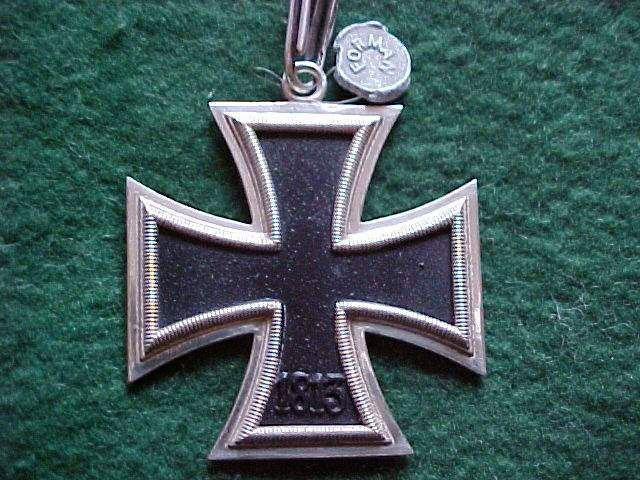
 0
0 -
A handsome 1939 pattern S&L KC with the beginnings of die flaws apparent on the beading.
PK
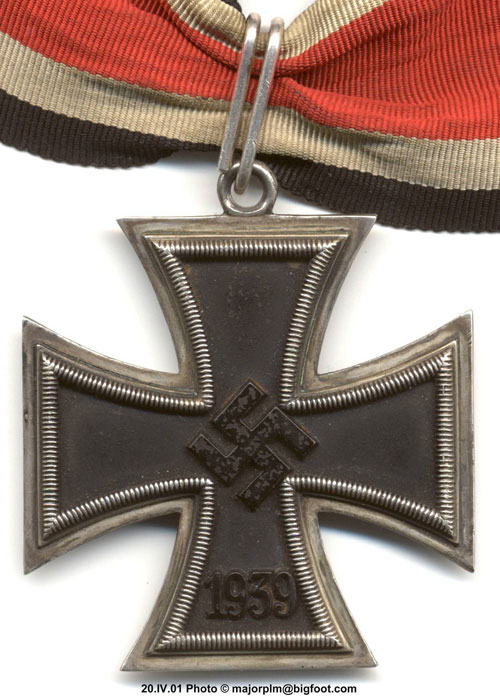
 0
0 -
The above 1957 cross has slight flaws on the beading, indicating that the frame haves were struck after the dies had suffered damage that worsened over the years. Below is an early 1957 RK by S&L with no apparent evidence of any die flaws at all.
PK
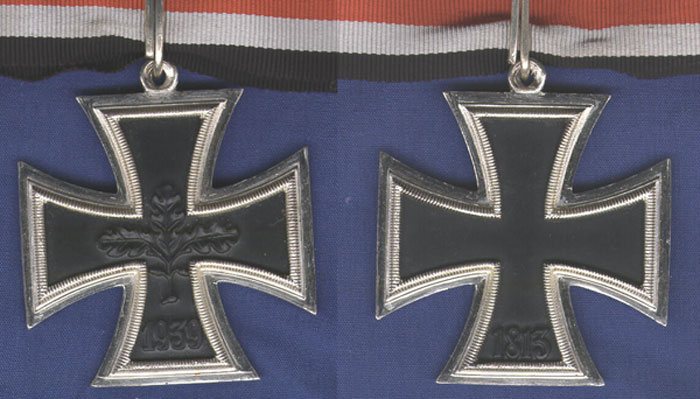
 0
0 -
Another indicator supporting the contention that we might have a rare unicorn photograph is the state of the jump ring on the supposed London fake. Note how it appears to have been worked with files to remove the die flashing, as on many wartime S&L KCs? Now take a look at a 1957 pattern KC by S&L below. Note how S&L didn't really bother reworking the jump rings? Why should they? The cross did the job.
PK
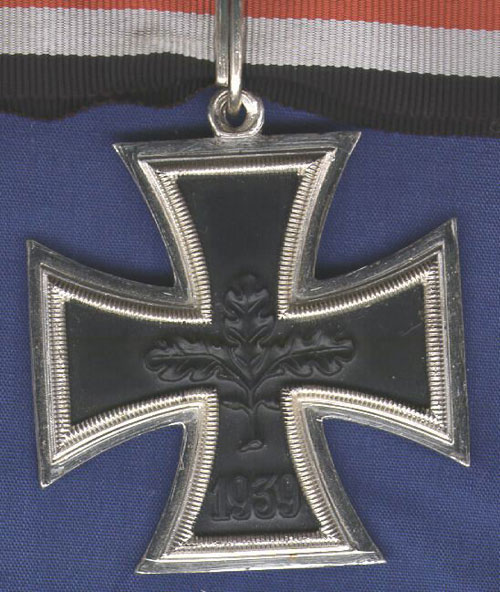
 0
0 -
On the trail of the unicorn: could this be a London-made Steinhauer & L?ck RK? It is an awful snapshot - someone sent it to me years ago - but appears to be a Knight's Cross with frames made using the flawed Steinhauer & L?ck dies. The die flaw marks are quite visible on the beading of the horizontal arms. What if anything suggests that it is a London-made cross rather than one of the crosses produced by S&L in the late 1970s or very early 1980s before the dies were sold to a London dealer in a covert deal? I do not think S&L marked their crosses with their wartime PKF Lieferant number and the silver content in this manner, do you?
PK
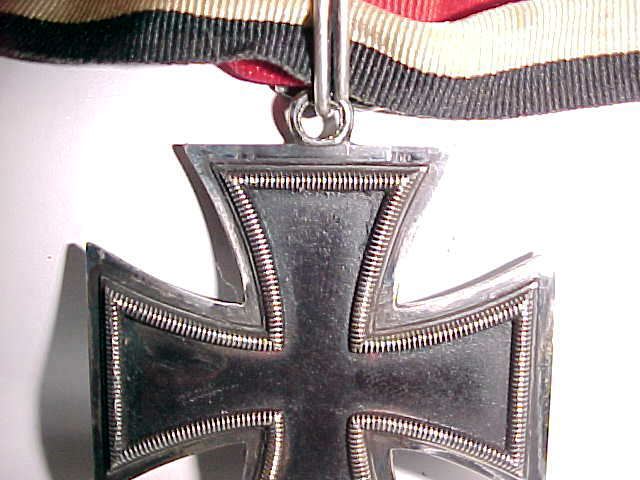
 0
0 -
Just curious, the SLR or L1A1 uncontrollable on full auto? But in the commonwealth it NEVER had the capability of doing that! There was a heavy barrel version that was select fire. The Canadian C1A1 later modified to the C2A1, but it was'nt very successful.
Performing "an illegal strip" and inserting a small object at a strategic point turned the British-issue SLR into a fully automatic weapon. I tried it once and it was fairly controllable but there was a risk of warping the barrel by subjecting it to sustained automatic fire. I never saw this happen but it is believable. We experimented with LMG magazines too but the springs weren't powerful enough to feed the rounds.
I was interested in the remark that the SA80 was heavier than the SLR. I'll take the man's word for it but I never noticed it myself. My limited experience with the SA80 before I turned my kit in was enough to convince me that it was a liability. I had one come apart during a jump and, no, it wasn't because I had my weapon sleeve on the wrong side of the container! The plastic bits came away from the metal bits and I had to tape the thing together for the rest of the exercise. I remember that the sight would de-zero itself if bumped even slightly during a tab or debussing.
I would say that the AK74 has to be one of the best all-round assault rifles from the viewpoint of being soldierproof and relatively simple to operate and maintain in the field. This is why so many armies and paramilitary groups, particularly in the Third World, favour the AK74 and, of course, the AK47. In terms of man-stopping power, it is as effective as the FN (SLR), the G3 and the old M14. Hit someone anywhere with a round from one of these weapons and they will go down. That can't be said of the SA80, M16 and all the other small calibre NATO spec weapons.
I heard that the reasoning behind the lighter rounds is that a wounded soldier ties up enemy resources. If true, this is typical backroom woolly thinking, courtesy of minds that cannot understand that "the enemy" today does not value human life very highly, beginning with his own soldiers. They won't stop to tend to their wounded in a battle. As one Chinese general famously remarked: "A hundred Chinese die for one American soldier...soon no American soldiers!". Or something like that...
PK
0 -
Let's not forget the Bacqueville issue. The French produced a series of KM war badges. Some people doubt that they are wartime but it is improbable that they are postwar fantasy pieces. The most likely scenario is that they were made on spec, so to speak, by the French firm of Bacqueville - which made other stuff for the Germans as well - sometime during the two-year period in which Berlin maintained the charade of Franco-German alliance, between June 1940 and July 1942. Many French firms - and people - curried favour with the Germans. In March 1941, the LDO tightened the rules governing the production and retail of state awards and qualification badges and Bacqueville probably fell foul of this. A consignment of these badges was found in the French Admiralty building on Place de la Concorde during renovation work in the 1970s. This building, naturally, served as KM HQ during the Occupation. Other examples have surfaced elsewhere and there is talk of a photo in the ECPA-D archives of some sailors in La Baule wearing French-made KM war badges but we have not found it yet.
PK
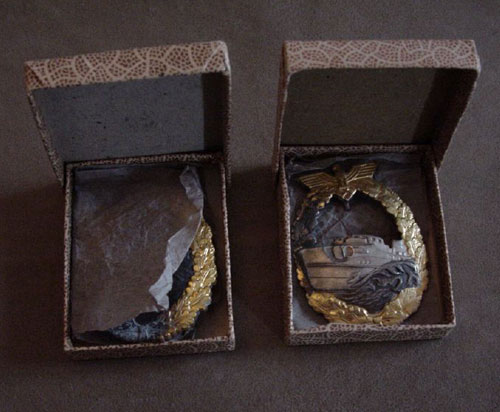
 0
0 -
Points conceded.
PK
0 -
-
An unmarked Juncker Type 2, obverse.

 0
0 -
Or into a hole, Don! Bew?hrungs-Soldaten - disciplinary probationers - were often men convicted of relatively minor offences and assigned to hard labour or dangerous occupations like mine clearance as non-citizens, deprived of their military and civil status. They would take the chance, when offered, to volunteer for combat duties with what they called Himmelsfahrt units, the soldiers' slang for Bew?hrungs-Bataillonen. This term translates as "Heavenbound unit", meaning suicide unit. As you can imagine, the casualty rate was quite high in such units. The carrot offered to these "lost souls" was rehabilitation through redemption of their lost honour on the field of battle. Many realised, doubtless as they lay coughing up their lifesblood in those final seconds before darkness claimed them, that it was simply exchanging a slow death in, say, the quarries of Mauthausen for a quicker death in battle. But death rehabilitated them so the family received any benefits going...and a nice letter from the CO with the dearly departed's medals and documents. In some cases, they were rehabilitated before they were killed, like Heinrich Stadlbauer here. Mind you, one can only guess at the state he was in as a Gold Wound Badge holder! Light duties only, I expect.
Half the initial intake of SS-Fallschirmj?ger-Btl 500 in November and December 1943 consisted of Bew?hrungs-Schutzen from various Waffen-SS punishment camps and labour battalions. They were deprived of the right to wear the sigrunen, to hold any rank above the lowest recruit level grade and to wear their decorations. They underwent jump training and were awarded, on paper, their jump badges. The unit was effectively wiped out twice during its year of existence, from October 1943 to October 1944, when the ninety survivors, plus men under training with the Field Training & Replacement Company, were posted to the newly forming SS-Fallschirmj?ger-Btl 600. There is a poignant little reference in the Signals Platoon war diary - an unofficial diary kept by a signaller who is still alive - to the last of the B-Schutzen removing their blank righthand collar patches and replacing them with the runic patches as they are transferred to the new unit. Only a handful of them, perhaps thirty of the survivors, were left out of between five and six hundred volunteers a year before. As a footnote of relevance to collectors of photography, one of the reasons for the rarity of photos of SS paratroopers wearing jump badges is that more than half the volunteers for SS-FJ-Btl 500 were not allowed to wear any badges until they were rehabilitated. The men you see wearing badges are always seen with runic collar patches and are often NCOs.
A Heinrich Stadlbauer shows up in the German war graves records so it looks as if he didn't survive WW2.
Nachname: Stadlbauer?Vorname: Heinrich?
Dienstgrad: Gefreiter?
Geburtsdatum: 09.01.1921?
Geburtsort: Aum?hl?
Todes-/Vermisstendatum: 28.01.1944?
Todesort: Bei Kolesnicki,ostw.Rowno?
Heinrich?Stadlbauer wurde noch nicht auf einen vom Volksbund errichteten Soldatenfriedhof ?berf?hrt oder konnte im Rahmen unserer Umbettungsarbeiten nicht geborgen werden. Nach den uns vorliegenden Informationen befindet sich sein Grab derzeit noch an folgendem Ort:
?
Kolesniki / Rowno - Ukraine
Is this the Heinrich Stadlbauer whose documents you have? Is it the same DoB?
PK
0 -
He was certainly a Bew?hrungs-Schutze. Infanterie-Ersatz-Bataillon 500 was formed in Fulda in October 1941 from Infanterie-Ersatz-Btl 500 and was subordinate to Division 159. Hainrich Stadibauer won the IC2, IAB and Silver Wound Badge at the same time, having received the Black Wound Badge in 1942. The soldbuch entry gives the award date for the Gold badge as 2.5.1944 and all the entries are by the same Landessch?tzen-Bataillon 501 officer, Stadibauer's company commander. However, the soldbuch is not a duplicate so this shows that while Stadibauer was awarded these decorations, he did not actually receive them and would not have been entitled to wear them until after his 'rehabilitation'. The Gold WB document was issued at Skierniewieze, which was where the HQ of Infanterie-Ersatz-Bataillon 500 was located during its time in Poland in 1943 and 1944. Infanterie-Ersatz-Bataillon 500 had been transferred in December 1943 to the Generalgouvernement (Poland), forming the nucleus of a training battalion with five companies. In 1944, the unit was enlarged to regimental size and moved to B?hmen-M?hren (Czechoslovakia). The Gold WB document was presumably filled out by the CO of Infanterie-Ersatz-Bataillon 500 before Stadibauer was posted off to Landessch?tzen-Bataillon 501 as a rehabilitated soldier and citizen.
PK
0 -
You've just seen one! Look above at the 1940 example I posted. The star device denoted the level of citation or subsequent awards but the cross could be awarded for an act of valour not mentioned in a dispatch to headquarters...if that makes sense.
PK
0 -
The WW1 air ace Guynemer, who had fifty-four victories, had twenty-seven palms on his riband, some of which, I think, were the silver class instituted later in the war to replace five bronze palms. Guynemer also had dozens of bronze and silver stars. His riband was about eighteen inches long! The WW2 ace Pierre Clostermann accumulated about a dozen palms.
Just for the benefit of those readers unfamiliar with the terms of the decoration, the Croix de Guerre was instituted on 8.4.1915 and was the only decoration awarded by France in World War One purely for valour on the battlefield. It was awarded to individuals of any rank who distinguished themselves by heroism in combat against enemy forces and also to anyone mentioned in dispatches for bravery in action. Subsequent acts of bravery on the part of recipients earned a bronze star for Regimental and Brigade citations, a silver star for Divisional citations, a gold star for Corps citations and a bronze palm leaf for Army citations. A common soldier of lowly rank from the mud and filth of the trenches sporting the Palme de Bronze on his green and red ribbon was a man to be treated with the greatest of respect. As we have seen, the Croix de Guerre could also be awarded to units that distinguished themselves.
The above summary answers the question of the member who asked it there were crosses with just the date '1914' on the reverse medallion. The short answer is no. They run 1914-1915, 1914-1916 (quite rare), 1914-1917 and 1914-1918. I am told that there was a 1914-1919 issue for soldiers serving in the Balkans and with the expeditionary forces in White Russia but have never seen one of these.
There are some wonderful things coming out of the woodwork in this thread, aren't there?
0 -
As you rightly point out, Andrew, sentiment cannot be a prime mover in the even-handed assessment of any legal case. But I am certain that a proportion of the cases could be reviewed and soldiers' names cleared, if only on the basis of "reasonable doubt" of their guilt as charged. There again, perhaps it is best to let it lie. Most people understand that many of the men shot did not deserve to die in that way and maybe it is kinder to allow families to convince themselves that the man in the faded photograph was not a coward or a felon but merely the victim of unjust punishment.
PK
0 -
Here's one from WW2. This was awarded to Pierre Ursault, a motorcycle reconnaissance rider serving with an artillery unit in 1940, for undertaking particularly risky missions between June 11th and 19th 1940, "often in very critical situations", which means that Ursault must have ridden into the lion's mouth so to speak, as the French Army fell back in front of the rapid German advance.
You can't see it here, of course, but another thing that makes this ensemble interesting is that the cross is a 1939-1940 issue, meaning that it is the Vichy pattern, approved for wear by the P?tain administration. So Ursault probably served in the new French Army or one of the paramilitary organisations. In further support of this thesis is the fact that the riband is the so-called "London type", meaning that it is of British manufacture. Perhaps Ursault quickly acquired the correct Republican riband after the Liberation and threw away his Vichy riband?
This item was rescued from a pile of trash outside a recently deceased widow's appartment building by a 'picker' who calls me when he gets nice things. Someone chucked this in the trash!
PK
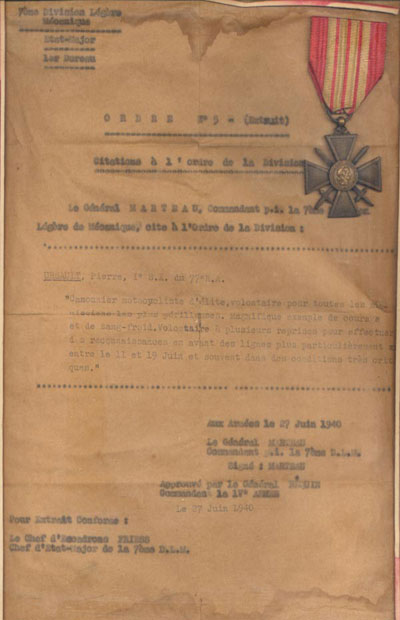
 0
0 -
Another nice line up. I would rate the French Croix de Guerre alongside the Iron Cross and the British Military Cross in asthetic terms. Such simple but eloquent designs. Don't know who this fellow was but he was active: six bronze palms. One of them is missing but the holes are there in the riband. Probably a flyer. The Bronze Palm represented a citation in Army dispatches. You had to do something very special to get the Palm. Flyers got one for each aerial victory. So it is reaosnable to presume that this cross was to a pilot because it would have very hard for a soldier or a sailor to accumulate six of them.
PK
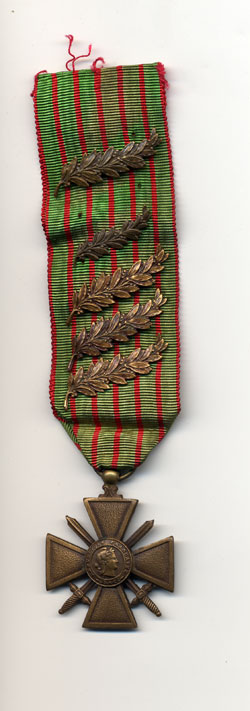
 0
0 -
The citation, which is on very fine paper and printed askew. Only one of the French collectors I know had ever seen one of these before.
PK
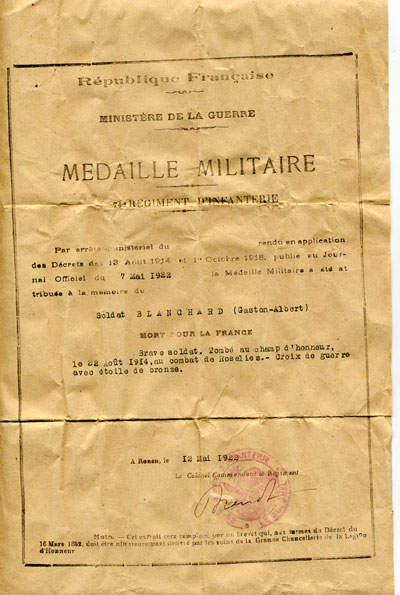
 0
0 -
You can find medals with cases from time to time in France. I have a couple of coin dealers and flea market dealers who call me when they get stuff. The problem in France, you see, is that the majority of ordinary people, when clearing out a late elderly relative's home, keep the medals to sell because they are made of metal and throw just about anything made of paper, including photographs, in the rubbish skip (dumptster, for our cousins across the Atlantic).
Here is another ensemble. I looked in the M?daille Militaire box, which is deliberately deep enough for two medals, and found these two medals, unworn. But tucked into the lid of the box was this citation, which is an extremely rare item. Poor Gaston Blanchard did not have much luck; he fell at the Battle of Rosalies on August 22nd 1914. He was posthumously decorated with the Crois de Guerre with Bronze Star, suggesting that he was mentioned in regimental or brigade dispatches, and then he was accorded the fairly rare distinction of a posthumous M?daille Militaire, normally only awarded to NCOs for bravery or General Officers for leadership.
PK
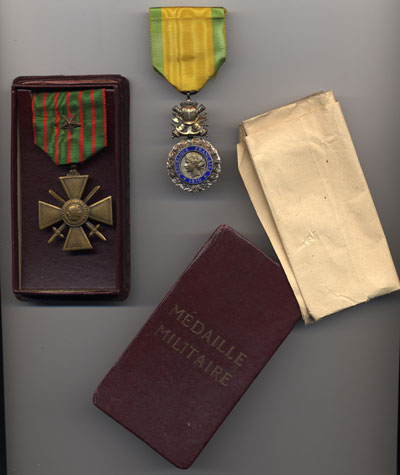
 0
0 -
That's a really nice line-up of 14-18 Croix de Guerre, Darrell. Vraiement dans leur jus. Here's something I reckon you'll appreciate. I found it in a fleamarket, complete with the dried violet, which the French adopted in the way that the British and Commonwealth adopted the poppy. Whoever the veteran was, he must put the flower in the case at some point, maybe after a reunion. It's rather touching, isn't it?
PK
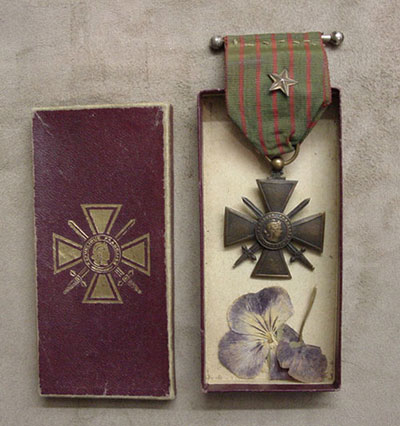
 0
0 -
Thank you, Rick! So I was misreading the 'T' as a 'J'. Now that I look at it again, of course I was! Thanks, old chap. I owe you one.
PK
0 -
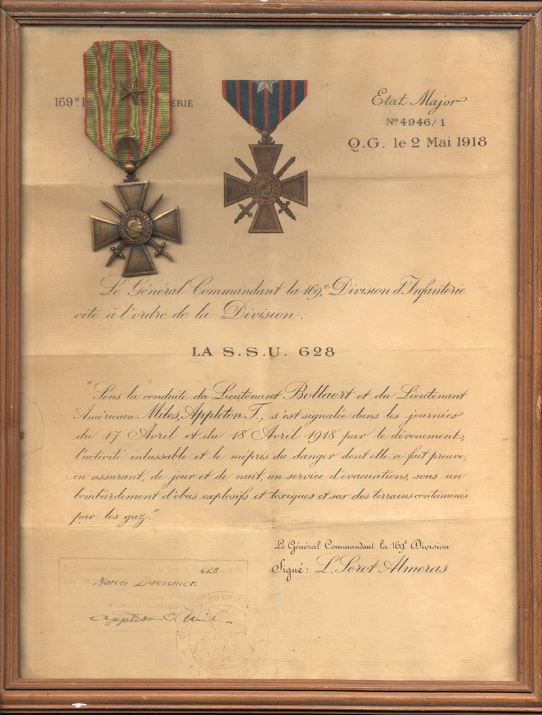
It just goes to show that real treasures can still be found if you're prepared to do the study and the legwork. Here is a Croix de Guerre citation I picked up here in Paris a while ago. The chap who sold it didn't really understand its significance, first of all that it is a Croix de Guerre unit citation and, moreover, to an American unit.
Below is an extract from a history of SSU 8/SSU 628, mentioning the gas attacks of April 17th and 18th and the unit citation. It also mentions that Lt Bollaert, the French liason officer, was later KIA. What is interesting is the name of the American OC, Lt Appleton J Miles, who has also signed the document across the unit stamp. He was surely a relative of the Indian Wars general and CMoH recipient Nelson Appleton Miles. A grandson, perhaps? Can any of you US Army history buffs help me with this?
PK
SSU 8/628Section 8 of the American Field Service left Versailles on May 25th 1916, going directly to Champagne in the Mourmelon sector. It remained there but a few days when it moved on to Dugny for the great battle of Verdun. It next served in the region of Les ?parges. Reward came in the form of an extended repos in the Moselle region, followed by a long journey to the Somme where it spent part of the winter of 1916-17. From there it went to the Meuse, thence to Sainte-M?nehould and the Argonne in the early spring of 1917. In April of the same year the Section went again to Verdun. From there it moved to Champagne, remaining until August, then returning once more to Sainte-M?nehould. It was while here that Eight was taken over by the Army in the autumn of 1917, becoming Section 628 of the U.S.A. Ambulance Service.
After it was enlisted in the United States Army, Section 8/628, remained in the Argonne, with front-line postes at La Haraz?e, Saint-Thomas, and Le Four de Paris untilFebruary 28, 1918, having during this time very little work. From February 28 until March 28, it was en repos at Saint-Ouen, Corbeil, and Herpont, small towns in the vicinity of Vitry-le-Fran?ois. From April 2 until June 9, it was in the Oise and Somme sectors in Picardy. It was cantoned at Coivrel, a small town south of Montdidier, and had postes at Dompierre, Domfront, Godenvillers, and Le Ployron. It sustained a gas attack April 17 and 18, for which the Section was cited to the order of the Division. The work was very heavy. Jack Keogh was wounded by a shell at Coivrel, and was in a hospital for two months.
From June 9 until August 19 it remained in the Oise sector, being cantoned at Ravenel, south of Montdidier. The French offensive here began on the 9th of August. The 169th Division, to which the Section was attached, advanced from Le Ployron to Fescamps, approximately twenty kilometres. The front postes during the attack were at Domfront, Rubescourt, Le Ployron, Assainvillers, Fescamps, and Bus. The Section's French Lieutenant, Lieutenant Bolla?rt, was killed, and Henri Werlemman, his French driver, was very gravely wounded in the leg at the poste at Rubescourt. The Section was cited for its work here.
From August 19 until September 7, the Section was en repos at Froissy, near Beauvais. It went back to the front again on September 7, and from this time until October 16 had some of its hardest work. It went into line just behind Ham at a town called Vilette. Its Division attacked and advanced from Ham to Saint-Quentin, and beyond to Mont Origny --- a distance of over thirty-five kilometres. In this advance the Division broke the Hindenburg line just in front of Saint-Quentin. The Section was here again cited for its work. During the advance from Ham to Mont Origny, it worked postes at Ham, Ollezy, Saint-Simon, Avesne, Clastres, Lizerolles, Essigny-le-Grand, Urvillers, Itancourt, Mesnil-Saint-Laurent, and Regny.
From October 16 until November 1, it was en repos at Cr?vec?ur-le-Grand, near Beauvais. On November 11, at the signing of the Armistice, the Section was at Guise. After the Armistice it proceeded with the French Army of Occupation into Belgium, passing through Le Nouvion, La Capelle, Trelon, Chimay, as far as Mariembourg. The Division was demobilized at La Nouvion January 22, 1919, and the Section went to Cr?py-en-Valois, outside of Paris until it was ordered to Base Camp in February.
From "Memorial Volume of the American Field Service in France, Friends of France, 1914 - 1918"
0 -
Obviously some of the men executed were dispatched in proper accordance with the law, such as it was in those days, but the fact remains that many men were shot pour encourager les autres, as the French put it. There was a French NCO shot for "mutiny" after refusing to wear the repaired trousers of a man who had died of his wounds. It's a well-documented case about which a film was made. My grandfather had to officiate at several executions, both on the Western Front and later during the Irish Civil War. One of the executions involved, apparently, a nineteen year old found wandering in a confused state on the battlefield without his weapon or webbing. He was charged with desertion in the face of the enemy, with throwing away his rifle and equipment - as per Sgt Stones - and shot. My grandfather said that the boy did not understand why he was being killed and begged for his life. One can only try to imagine the scene and how everyone involved in it felt. There is a difference between meting out military justice to a deserving criminal and aiming a rifle at a terrified man who hasn't committed any real crime, who was called up to fight in a war conceived and run for the benefit of the rich and for shareholders, as one view of WW1 has it. You know, one can go on and on about how that was how things were then but that doesn't make it any more excusable than burning old ladies at the stake in the name of religion or superstition just because "that's how things were then", if you take my point. Killing people for suffering nervous breakdowns or shock was barbaric and that is all there is to it. How hard would it be for a specially appointed panel of retired soldiers, academics, churchmen and lawyers to sit and go through the cases, eliminating the obvious criminals from the list before putting a plaque up in Westminster Abbey or some such location with all the names of those who were put in front of firing parties for dubious reasons? I'd rather see taxpayers' money spent on amends to the memory and the descendants of those men than on some of the crazier projects fostered by political correctness.
PK
0





S&L RKs -- made in Britain
in Germany: All Eras: The Iron Cross
Posted
The dies were in London early in the summer of 1981. I know because I saw them with my own eyes when they were offered to the late Jeff Craig alias Hurst. He hesitated because of the damage and the dies were reportedly sold to Adrian Forman. I cannot prove that Forman bought them and nor can I prove that he ever produced KCs using them but the question is academic as far as I am concerned because I view all 1939 pattern S&L KCs with die flaws as suspect, no matter how anyone tries to explain them.
PK